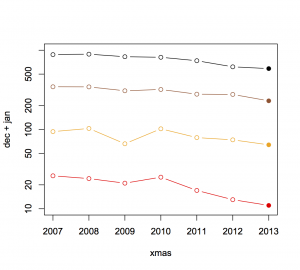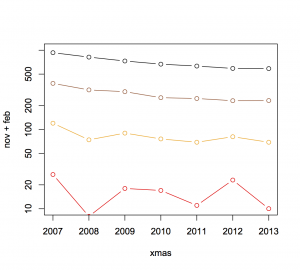Speed, crashes, and tolerances
The police think the speed tolerance change last year worked
Last year’s Safer Summer campaign introduced a speed tolerance of 4km/h above the speed limit for all of December and January, rather than just over the Christmas and New Year period. Police reported a 36 per cent decrease in drivers exceeding the speed limit by 1-10km/h and a 45 per cent decrease for speeding in excess of 10km/h.
Fatal crashes decreased by 22 per cent over the summer campaign. Serious injury crashes decreased by 8 per cent.
According to data from the NZTA Crash Analysis System, ‘driving too fast for the conditions’ was one of the contributing factors in about 20% of serious injury crashes and 30% of fatal crashes over the past seven years. The reductions in crashes seem more than you’d expect from those reductions in speeding.
So, I decided to look at the reduction in crashes where speed was a contributing factor, according to the Crash Analysis System data.
Here’s the trend for December and January, with the four lines showing all crashes where speed was a factor, those with any injury, those with a severe or fatal injury, and those with a fatality. The reduced-tolerance campaign was active for the last time period, December 2013 and January 2014. It looks as though the trend over years is pretty consistent.
For comparison, here’s the trend in November and February, when there wasn’t a campaign running, again showing crashes where speed was listed in the database as a contributing cause, and with the four lines giving all, injury, severe or fatal, and fatal.
There really isn’t much sign that the trend was different last summer from recent years, or that the decrease was bigger in the months that had the campaign. The trend of fewer crashes and fewer deaths has been going on for some time. Decreases in speeding are part of it, and the police have surely played an important role. That’s the context for assessing any new campaign: unless you have some reason to think last year was especially bad and the decrease would have stopped without the zero-tolerance policy, there isn’t much sign of an impact in the data.
The zero tolerance could be a permanent part of road policing, Mr Bush said.
“We’ll assess that at the end of the campaign, but I can’t see us changing our approach on that.”
No, I can’t either.
Thomas Lumley (@tslumley) is Professor of Biostatistics at the University of Auckland. His research interests include semiparametric models, survey sampling, statistical computing, foundations of statistics, and whatever methodological problems his medical collaborators come up with. He also blogs at Biased and Inefficient See all posts by Thomas Lumley »


Hi Prof Lumley
A couple of years ago I requested data from the Police on infringement notices against MOT data on the causes of injury crashes. What was notable was that the two biggest infringement notice types (speed, and vehicle faults) accounted for only about 20% of all injury crashes… but 60+% of infringement notices.
I have the data in a spreadsheet if you would like it.
Cheers
9 years ago
That doesn’t seem inappropriate to me. Speed and (some) vehicle faults are observable externally, and so infringement is easier to detect without undue burden on people who aren’t infringing. Drunk driving, on the other hand, can’t be reliably assessed without stopping people, so there would more burden on those complying with the law if you checked everyone.
9 years ago
Interesting post. We ofren see agencies trumpeting how their efforts over the course of a short period of time saved the world, and I appreciate your calling them out on the need to wait for more data to come in.
You expressed intuition that the claimed fall in crash rates was “more than you’d expect from those reductions in speeding.” I’m not suprised at all: crash rates, and especially fatal crash rates, are a much more than linear function of speed in the range between 0kph and about 60kph. See, e.g., http://www.nhtsa.gov/people/injury/research/pub/HS809012.html . Converting the segment in the abstract about hitting pedestrians to a table (and Metric):
speed | P(fatal|crash)
32kph | 5%
48kph | 40%
64kph | 80%
Similar more-than-linear relations hold for the crash rate generally, due to simple mechanics of reaction time and stopping distance. So we’ll need more data before we can say anything definitive, but a 10kph reduction in speed leading to a 22% reduction in fatal crashes doesn’t seem out of line from expectations.
9 years ago
If a 100% reduction in speeding would lead to 30% reduction, getting a 22% reduction should still require a big reduction in speeding.
9 years ago
More to the point, though, there hasn’t been a specific reduction in crashes where speed was a contributing cause.
9 years ago
According to police PR if crashes decrease its because of their enforcement and if they increase its because of bad driving.
Statistics are irrelevant and are a mere propaganda tool rather than a properly analytical one.
9 years ago
But you don’t need to trust their interpretation. The data are available.
9 years ago
All the above comments fail to mention several critical points:
1) 80% of fatal accidents occur below the speed limit.
2) The 20% of fatal accidents above the speed limit are almost exclusively yobbos, motorcyclists or impaired drivers.
The endless ticketing of people outside these groups cannot be convincingly linked to the 20% of drivers who die above the speed limit and who are largely immune to either road safety messages, fines or disqualification.
http://www.bocsar.nsw.gov.au/bocsar/bocsar_mr_cjb106.html
A 2009 AA summary of 300 fatal accidents, concluded:
“…government advertising suggests you should be grateful to receive a speeding ticket because it will save your life. In fact, exceeding speed limits isn’t a major issue. Police surveying has found that even the top 15% of open-road speeders average under the 110km/h ticketing threshold.”
The AA report also criticised the idea that illegal speeds by ordinary drivers were the cause of road fatalities.
“… [It is not] true that middle-New Zealand drivers creeping a few kilometres over the limit on long, empty [roads were a major factor in] the road toll…”
The AA report pointed out that a high percentage of speed-related fatalities were:
“caused by people who don’t care about any kind of rules. These are men who speed, drink, don’t wear safety belts, have no valid license or WoF – who are basically renegades. They usually end up wrapped around a tree, but they can also overtake across a yellow line and take out other motorists as well.”
In other words, the basic premise behind the police campaign, that you can stop high risk behavior by a tiny minority of drivers who tend to be alienated from everyday society, by targeting low-risk behavior by mainstream drivers, is simply without foundation. There is little tangible link between the two groups.
9 years ago
The issue in NZ is whether the speed limit should be what’s printed on the signs, or what’s printed on the signs + 5 km/h. This argument doesn’t seem to differentiate between those options — unless you’re arguing that speed limits should always and everywhere be higher (or non-existent).
9 years ago
First, one of the reasons the police have traditionally allowed a 10kp/h tolerance for speeding campaigns is because the speedos on New Zealand vehicles are notoriously inaccurate. Many are decades old and have not been calibrated since they left the factory. Also, simply putting a larger or smaller set of wheels on your car will also mean your speedo is no longer working accurately.
Second, a rigidly enforced speed limit fails to take into account issues such as overtaking. If I had to make the choice between obeying the speed limit and having a head-on collision with an oncoming car, I know which option I’d choose.
The police, correctly, have wide discretion over enforcement, even when their is a clear breach of the law.
For example, in Britain (and quite possibly New Zealand) about 10% of adults are estimated to have filed false insurance claims.
http://www.private-investigators.uk.com/false-insurance-claims.html
Yet the police only investigate a fraction of these false claims. Why? Not because they approve of fraudulent behavior, but because they have much more serious crimes to focus on.
The same can be argued regarding minor breaches of the speed laws.
To requote the AA:
“… [It is not] true that middle-New Zealand drivers creeping a few kilometres over the limit on long, empty [roads were a major factor in] the road toll…”
Why, therefore, are the police continuing expensive and time-consuming policies that don’t appear to be making any difference to the road toll, because they’re aimed at the wrong groups?
9 years ago